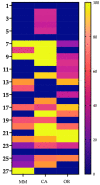Intraspecific Differences in the Venom of Crotalus durissus cumanensis from Colombia
- PMID: 36006194
- PMCID: PMC9416679
- DOI: 10.3390/toxins14080532
Intraspecific Differences in the Venom of Crotalus durissus cumanensis from Colombia
Abstract
Biochemical and biological differences in the venom of Crotalus durissus cumanensis from three ecoregions of Colombia were evaluated. Rattlesnakes were collected from the geographic areas of Magdalena Medio (MM), Caribe (CA) and Orinoquía (OR). All three regionally distributed venoms contain proteases, PLA2s and the basic subunit of crotoxin. However, only crotamine was detected in the CA venom. The highest lethality, coagulant, phospholipase A2 and hyaluronidase activities were found in the MM venom. Also, some differences, observed by western blot and immunoaffinity, were found in all three venoms when using commercial antivenoms. Furthermore, all three eco-regional venoms showed intraspecific variability, considering the differences in the abundance and intensity of their components, in addition to the activity and response to commercial antivenoms.
Keywords: Crotalus durissus cumanensis; antivenom; venom.
Conflict of interest statement
The authors declare no conflict of interest.
Figures








Similar articles
-
Biological and Medical Aspects Related to South American Rattlesnake Crotalus durissus (Linnaeus, 1758): A View from Colombia.Toxins (Basel). 2022 Dec 15;14(12):875. doi: 10.3390/toxins14120875. Toxins (Basel). 2022. PMID: 36548772 Free PMC article. Review.
-
Immunorecognition and Neutralization of Crotalus durissus cumanensis Venom by a Commercial Antivenom Produced in Colombia.Toxins (Basel). 2022 Mar 25;14(4):235. doi: 10.3390/toxins14040235. Toxins (Basel). 2022. PMID: 35448844 Free PMC article.
-
Snake venomics of the Central American rattlesnake Crotalus simus and the South American Crotalus durissus complex points to neurotoxicity as an adaptive paedomorphic trend along Crotalus dispersal in South America.J Proteome Res. 2010 Jan;9(1):528-44. doi: 10.1021/pr9008749. J Proteome Res. 2010. PMID: 19863078
-
Geographic and ontogenic variability in the venom of the neotropical rattlesnake Crotalus durissus: pathophysiological and therapeutic implications.Rev Biol Trop. 2002 Mar;50(1):337-46. Rev Biol Trop. 2002. PMID: 12298262
-
Structure and function relationship of crotoxin, a heterodimeric neurotoxic phospholipase A2 from the venom of a South-American rattlesnake.Adv Exp Med Biol. 1996;391:197-202. doi: 10.1007/978-1-4613-0361-9_12. Adv Exp Med Biol. 1996. PMID: 8726057 Review. No abstract available.
Cited by
-
Biological and Medical Aspects Related to South American Rattlesnake Crotalus durissus (Linnaeus, 1758): A View from Colombia.Toxins (Basel). 2022 Dec 15;14(12):875. doi: 10.3390/toxins14120875. Toxins (Basel). 2022. PMID: 36548772 Free PMC article. Review.
-
Phenotypic dichotomy in Crotalus durissus ruruima venom and potential consequences for clinical management of snakebite envenomations.PLoS Negl Trop Dis. 2025 Aug 1;19(8):e0013296. doi: 10.1371/journal.pntd.0013296. eCollection 2025 Aug. PLoS Negl Trop Dis. 2025. PMID: 40749023 Free PMC article.
-
Knowledge about Snake Venoms and Toxins from Colombia: A Systematic Review.Toxins (Basel). 2023 Nov 15;15(11):658. doi: 10.3390/toxins15110658. Toxins (Basel). 2023. PMID: 37999521 Free PMC article.
References
-
- Uetz P., Freed P., Aguilar R., Hošek J. The Reptile Database. [(accessed on 14 June 2022)]. Available online: https://reptile-database.reptarium.cz/species?genus=Crotalus&species=dur....
-
- Lynch J. El contexto de las serpientes de Colombia con un análisis de las amenazas en contra de su conservación. Rev. Acad. Colomb. 2012;36:435–449.
-
- Ayerbe S. Ofidismo en Colombia. Enfoque, diagnóstico y tratamiento. In: Ordóñez C., Ferrada R., Buitrago R., editors. Cuidado Intensivo Y Trauma. Distribuna; Bogotá, Colombia: 2009. pp. 1143–1168.
-
- Lynch J., Angarita-Sierra T., Ruiz-Gómez F. Programa Nacional para la Conservación de las Serpientes Presentes en Colombia. Ministerio de Ambiente y Desarrollo Sostenible; Bogotá, Colombia: Universidad Nacional de Colombia, Instituto Nacional de Salud; Bogotá, Colombia: 2014.
-
- Carbajal-Márquez R.A., Cedeño-Vázquez J.R., Martínez-Arce A., Neri-Castro E., Machkour-M’Rabet S.C. Accessing cryptic diversity in Neotropical rattlesnakes (Serpentes: Viperidae: Crotalus) with the description of two new species. Zootaxa. 2020;4729:451–481. doi: 10.11646/zootaxa.4729.4.1. - DOI - PubMed
Publication types
MeSH terms
Substances
LinkOut - more resources
Full Text Sources

